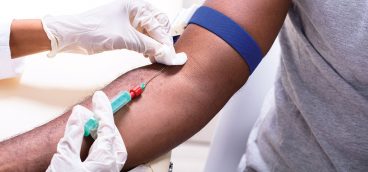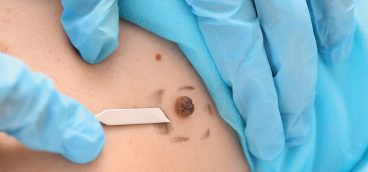More Than Skin Deep

As a teen growing up in Mt. Washington, Jessica Vega Rogowicz remembers her dad being diagnosed with skin cancer. He went to the doctor to have it removed and came home with a Band-Aid on his nose. Because he had basal cell carcinoma, which rarely spreads beyond the skin, that was pretty much the end of his brush with cancer.
By age 24, Rogowicz would begin her own, and much different, battle with skin cancer.
“I vividly remember getting the call that the mole on my back was melanoma. It was Halloween Day 2007, three days shy of my 25th birthday,” she writes in her blog titled “I Won’t Get Cancer, I’m Too Young.”
Four years later, melanoma reappeared, this time on the back of her leg. Fortunately, both cancers were caught early enough to be cured with surgery.
“One of the interesting things about this disease is that when you think about what are the real cancer killers of young women, melanoma ranks way up there. Most people don’t realize it’s a much bigger killer than breast cancer,” says Howard Edington, M.D., Rogowicz’s oncology doctor.
If caught early, melanoma is highly treatable. But once it grows into the skin, even just a millimeter, it can start to spread to vital organs.
Although melanoma accounts for less than 5 percent of all skin cancer cases, it causes a large majority of skin cancer deaths (an estimated 9,500 for 2013). Reaching across the age spectrum, melanoma is the most common form of cancer among 25-to-29-year-olds and the second most common cancer among adolescents. But more than half of the nation’s melanoma deaths are men over age 50. (One study suggests the reason may be that men are less likely than women to have an irregular mole checked out by a doctor.)
Edington performs 10 to 20 melanoma surgeries each week; his patients range from 7 to 95 years old. Edington had a long career with UPMC and the Melanoma Center at University of Pittsburgh Cancer Institute (UPCI). In 2012, he was tapped by West Penn Allegheny Health System to chair its department of surgery and direct its Cutaneous Oncology Center.
Over the past 30 years, incidents of melanoma have increased significantly—as has tanning bed use. Years ago, someone in her mid 30s had a one in 1,500 chance of getting melanoma. Now it’s one in 50. “Unlike other cancers, melanoma is going up dramatically. No one knows why,” Edington says. While there is an unequivocal link between sun exposure and basal and squamous cell skin cancers (which typically affect those over 35 and rarely spread beyond the skin), the sun exposure-melanoma link is not so clear. “We are seeing it in young patients so it can’t purely be sun exposure. The current consensus is that it is a mixture of genetic and environmental components.”
While most often the first sign of melanoma is an irregular mole, it can hide in dark places like the rectum, throat or vagina.
Rogowicz is convinced that her desire to look good almost cut her life short. By her 20s, she had become a regular at the tanning salon. She also had countless sunburns during summer family vacations in Ocean City, Md. As a middle school math teacher, she spent part of her summers basking the sun.
“It’s just hard because I did this to myself. It wasn’t just dumb luck. It was me being stupid and caring about the way I looked more than my health,” says Rogowicz, now 30, who lives in Baldwin with her husband and their young daughter.
Since her bouts with melanoma, Rogowicz has become adamant about protecting herself and her child from the sun. For the rest of her life, she will need to see her dermatologist and oncologist three to four times a year, as melanoma often recurs. She’s also on a crusade to let others know that skin cancer isn’t a disease to take lightly.
Thinking back on her dad’s brush with skin cancer and needing not much more than a Band-Aid, she says, “For me, that’s what I thought skin cancer was. I was willing to take that risk just to have a tan.”
A few days before her second melanoma diagnosis, Rogowicz decided to organize the first Miles Against Melanoma 5K in Pennsylvania. (This national non-profit started in St. Louis.) The next Miles Against Melanoma PA 5K Run/Walk is set for June 15 in South Park (Register at mampa.org).
Last year, about 660 runners and walkers took part. The 5K and other events sponsored by Miles Against Melanoma raised more than $25,000. Rogowicz presented a check to Dr. John Kirkwood, an internationally renowned melanoma researcher and director of UPCI’s Melanoma Center. (Learn more about breakthroughs in melanoma treatment in the accompanying sidebar.)
One of last year’s 5K participants was Kristin Colbert, who grew up in Carrick and lived in Mt. Washington. Rogowicz never met the 31-year-old woman but attended her funeral six months after the 5K. Colbert’s team raised over $2,000 for melanoma research and Rogowicz named Colbert honoree of the first annual Sunscreen Open Golf Outing held May 4 at Lake Arthur Golf Club in Butler, one of several local events Rogowicz and eight other MAM board members have organized.
“I remember her team name coming through the registration and her being the same age as me,” Rogowicz says. “At her funeral, I saw that the only thing in her casket was a Miles Against Melanoma T-shirt. I remember thinking, ‘This could be my funeral.’ It was really tough.”




